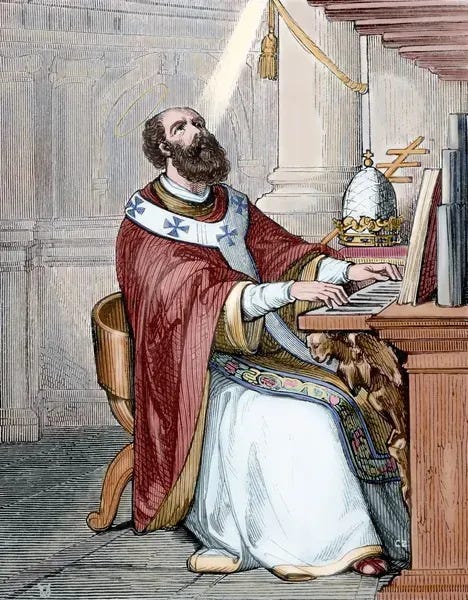Leo II: The Echo of Chalcedon
The Second of the Leos | Pope St. Leo II (682–683 AD)
“He [Christ] took what was ours to make it His own, so that we might receive what is His.”
— St. Leo II, paraphrasing the Fathers
When the name Leo once again graced the See of Peter, over two centuries had passed since St. Leo the Great had roared for the Incarnation. Rome had changed. Empires rose and fractured. New heresies festered in the wounds of ancient ones. But God, in His providence, had not abandoned His Church, nor the name that had once turned back Attila with prayer and peace.
In 682 AD, a man of gentle learning and liturgical beauty ascended the throne of Peter: Pope Leo II. His reign lasted only eleven months, but his voice, like an echo of his namesake, rang out to finish what others had begun—namely, the work of healing the wounds left by Monothelitism.
The Monothelite Heresy
The great theological battle of Leo II’s time was a Christological error that crept in like a shadow of earlier heresies: Monothelitism—the belief that Christ had only one will, rather than two (divine and human).
Though Monophysitism (which denied Christ’s full humanity) had been refuted at Chalcedon (451 AD), Monothelitism arose as a compromise, attempting to unite divided factions by diminishing Christ’s humanity not in nature, but in will.
Leo II did not initiate the battle. His predecessor, Pope Agatho, had already condemned the error and helped bring about the Third Council of Constantinople (680–681 AD), which affirmed the truth: that Christ, in His full humanity and divinity, possessed two wills in perfect harmony.
But it fell to Leo II to ratify and promulgate the Council’s teachings throughout the West. He did so with clarity, conviction, and charity.
A Lion with a Scalpel
Where Leo I had been a lion of confrontation, Leo II was a lion of precision. His most famous act was confirming the anathemas against heresy—even against his papal predecessor, Honorius I, who had failed to speak clearly against Monothelitism and had allowed error to fester.
This is a moment often misunderstood, even weaponized by critics of papal infallibility. But Leo II made a critical distinction. He did not accuse Honorius of heresy, but rather of “fostering it through negligence” (propagationem non repressit, sed negligenter permisit). In other words, Honorius failed to exercise his office properly—not that he taught heresy ex cathedra.
Thus, Leo II becomes a witness to the integrity of the papacy itself: affirming truth, correcting error, and showing that even Popes are judged by the eternal deposit of faith.
A Heart for Liturgy and Language
Leo II was not only a theologian. He was also a gifted musician and linguist. Fluent in both Latin and Greek, he was able to communicate with the Eastern Church in a way few Western bishops could. His command of the Greek language allowed him to translate and interpret the acts of the Council of Constantinople, ensuring they were understood and accepted in the West.
He is also remembered for his contribution to the chant and liturgy of the Roman Church, preserving sacred tradition through beauty. In the dark corridors of doctrinal controversy, he lit a candle of music and clarity.
A Short Reign, An Eternal Echo
Pope Leo II died on July 3, 683 AD, after less than a year in office. Yet his papacy reminds us of something often forgotten: that truth is not always thunderous. Sometimes, it arrives as a whisper in the sanctuary, or a letter ratifying what is already known, or a hymn sung in harmony with the Church triumphant.
He was buried in St. Peter’s Basilica, and canonized a saint—his feast once observed on July 3, now remembered on June 28 alongside his namesake, St. Leo the Great.
“Let your speech be always in grace seasoned with salt: that you may know how you ought to answer every man.”
— Colossians 4:6, Douay-Rheims
In an age where silence can be mistaken for peace, and ambiguity for mercy, Leo II teaches us the quiet courage of precise charity—the kind that corrects with clarity and loves with truth.
The Gentle Roar
Not every Leo must face a Hun or define a Council. Some must simply finish what was started. Some must mend what was cracked. Some must whisper doctrine into the ears of a tired Church and remind her who Christ is: fully God, fully man, with a divine and human will—so that we may be fully redeemed.
Leo II was not a lion who roared across history. He was a lion who hummed in harmony with the Logos.
And yet, his voice remains.


